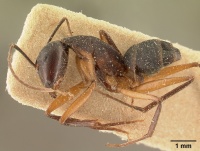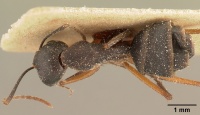Camponotus becki
| Camponotus becki | |
|---|---|

| |
| Scientific classification | |
| Kingdom: | Animalia |
| Phylum: | Arthropoda |
| Class: | Insecta |
| Order: | Hymenoptera |
| Family: | Formicidae |
| Subfamily: | Formicinae |
| Tribe: | Camponotini |
| Genus: | Camponotus |
| Subgenus: | Myrmosaga |
| Species: | C. becki |
| Binomial name | |
| Camponotus becki Santschi, 1923 | |
Based on recent collection data, Camponotus becki is restricted to the ericoid thickets and montane rainforests of the PN Andringitra. The species has been found nesting under stones and foraging on the ground. (Rakotonirina & Fisher, 2022)
Identification
Rakotonirina and Fisher (2022) - With head in full-face view, lateral margins of head anterior to eye level parallel and lacking erect hairs, lateral cephalic margin rounding to posterior margin, anteromedian clypeal margin truncate; propodeal dorsum more or less straight and joining declivity surface at a broad angle; body color black to dark brown.
See also discussion under Camponotus asara.
Keys including this Species
Distribution
Distribution based on Regional Taxon Lists
Malagasy Region: Madagascar (type locality).
Distribution based on AntMaps
Distribution based on AntWeb specimens
Check data from AntWeb
Countries Occupied
| Number of countries occupied by this species based on AntWiki Regional Taxon Lists. In general, fewer countries occupied indicates a narrower range, while more countries indicates a more widespread species. |

|
Estimated Abundance
| Relative abundance based on number of AntMaps records per species (this species within the purple bar). Fewer records (to the left) indicates a less abundant/encountered species while more records (to the right) indicates more abundant/encountered species. |

|
Biology
Castes
Images from AntWeb
   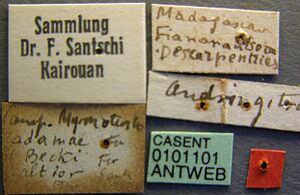
| |
| Worker (major/soldier). Specimen code casent0101101. Photographer April Nobile, uploaded by California Academy of Sciences. | Owned by NHMB, Basel, Switzerland. |
   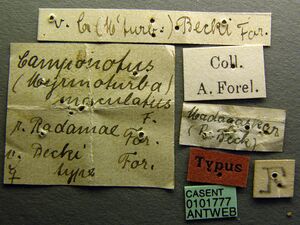
| |
| Paralectotype of Camponotus becki. Worker (major/soldier). Specimen code casent0101777. Photographer Nick Olgeirson, uploaded by California Academy of Sciences. | Owned by MHNG, Geneva, Switzerland. |
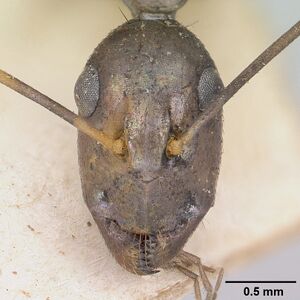   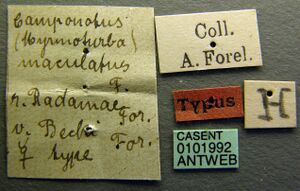
| |
| Lectotype of Camponotus becki. Worker. Specimen code casent0101992. Photographer Nick Olgeirson, uploaded by California Academy of Sciences. | Owned by MHNG, Geneva, Switzerland. |
Nomenclature
The following information is derived from Barry Bolton's Online Catalogue of the Ants of the World.
- becki. Camponotus (Myrmoturba) radamae st. becki Santschi, 1923e: 292.
- [First available use of Camponotus (Myrmoturba) maculatus r. radamae var. becki Forel, 1914d: 251 (w.) MADAGASCAR; unavailable (infrasubspecific) name.]
- Type-material: lectotype minor worker (by designation of Rakotonirina & Fisher, 2022: 53), 1 paralectotype major worker.
- Type-locality: lectotype Madagascar: (no further data) (R. Beck) (received from Donisthorpe); paralectotype with same data.
- Type-depository: MHNG.
- Combination in C. (Tanaemyrmex): Emery, 1925b: 86;
- combination in C. (Myrmosaga): Rakotonirina & Fisher, 2022: 53.
- As unavailable (infrasubspecific) name: Emery, 1920c: 6; Wheeler, W.M. 1922a: 1041; Emery, 1925b: 86.
- Subspecies of hova: Bolton, 1995b: 88.
- Status as species: Rakotonirina & Fisher, 2022: 53 (redescription).
- Distribution: Madagascar.
- Material of the unavailable name altior referred here by Rakotonirina & Fisher, 2022: 53.
Unless otherwise noted the text for the remainder of this section is reported from the publication that includes the original description.
Description
Worker
Rakotonirina and Fisher (2022):
Morphological measurements: see Appendix 1 and Ratios of morphometric data for majors and minors
Minor With head in full-face view, lateral margins anterior to level of eye parallel, rounding evenly to a straight posterior margin; eye more or less convex (EL/CS: 0.27±0.02; 0.25–0.30), not breaking lateral cephalic margin, level of its posterior margin located generally at posterior 1/4 of head (PoOc/CL: 0.26±0.01; 0.24–0.27); frontal carinae posteriorly parallel (FR/CS: 0.27±0.01; 0.26–0.29); clypeus without well-defined anterolateral angle and with anteromedian margin broadly convex; mandible with two apical teeth distantly spaced; antennal scape relatively long (SL/CS: 0.27±0.01; 0.26–0.29). Promesonotum weakly convex, mesopropodeum generally flat; mesonotum with posterior portion flat immediately anterior to a weakly visible metanotal groove; propodeal dorsum anteriorly convex and posteriorly flat, joining declivity blunt angle; propodeal dorsum 2 × as long as declivity. Petiolar node short and high, its dorsal margin rounding to anterior face, height of its anterior face 2/3 that of posterior face; femur of hind leg flattened laterally, twisted near base.
First and second gastral tergites usually without white spots; lateral margin of head without erect hairs; two erect hairs near posterior margin of head; antennal scape only covered with appressed hairs. Pronotum with a pair of erect hairs; posterodorsal angle of propodeum with a pair of erect hairs.
Major With characteristics of minor worker except: enlarged head (CS: 2.80±0.23; 2.54–2.96; CWb/CL: 0.97±0.03; 0.94–1.00) with slight, medially concave posterior margin; apical 1/3 of antennal scape surpassing posterior cephalic margin; robust mesosoma, metanotum distinctly visible; propodeal dorsum same length as declivity; petiolar node flattened anteroposteriorly.
Type Material
- Syntype workers, Madagascar (R. Beck) (MHNG) [Rakotonirina & Fisher, 2022]; 1 syntype minor worker designated as lectotype, by present designation, AntWeb CASENT0101992 (MHNG) [Rakotonirina & Fisher, 2022].
- Paralectotype major worker CASENT0101777 (MHNG) [Rakotonirina & Fisher, 2022].
The worker specimens that are the basis of the unavailable name Camponotus (Myrmoturba) radamae st. becki var altior Santschi, 1923: 292 from Madagascar, Monts Andringitra, point culminant de l’île (Descarpentries) are referred here, AntWeb CASENT0101100 (NHMB) [Rakotonirina & Fisher, 2022].
References
- Bolton, B. 1995b. A new general catalogue of the ants of the world. Cambridge, Mass.: Harvard University Press, 504 pp. (page 88, Subspecies of hova, catalogue)
- Emery, C. 1925d. Hymenoptera. Fam. Formicidae. Subfam. Formicinae. Genera Insectorum 183: 1-302 (page 86, Combination in C. (Tanaemyrmex))
- Rakotonirina, J.C., Fisher, B.L. 2022. Revision of the Malagasy Camponotus subgenus Myrmosaga (Hymenoptera, Formicidae) using qualitative and quantitative morphology. ZooKeys 1098: 1–180 (doi:10.3897/zookeys.1098.73223).
- Santschi, F. 1923e. Descriptions de nouveaux Formicides éthiopiens et notes diverses. I. Rev. Zool. Afr. (Bruss.) 11: 259-295 (page 292, worker described)
- Wheeler, W. M. 1922k. Ants of the American Museum Congo expedition. A contribution to the myrmecology of Africa. IX. A synonymic list of the ants of the Malagasy region. Bull. Am. Mus. Nat. Hist. 4 45: 1005-1055 (see also)
